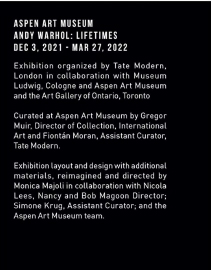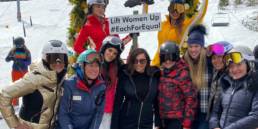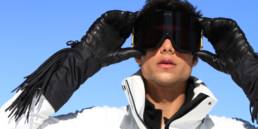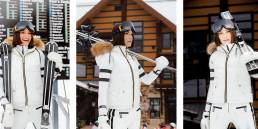Skiing was an afterthought for the celebrated Pope of Pop – but that wouldn’t stop Warhol from being an A-list Aspenite for more than 20 years.
An unlikely regular, AndyWarhol- but that says as much bout Aspen as about the famously urban-centric auteur himself. Long attracted to Aspen neither for the ski scene nor the vibrant art scene – Warhol was here for the glamorous, glittering parties.
For the past half-century, Aspen’s social scene has overflowed with what Warhol loved most of all – famous, provocative, interesting people. He compared it to a p/ein air Studio 54, his favorite New York haunts and, from John Denver and Goldie Hawn to Don Johnson, Barbra Streisand, and the rest, Warhol never lacked for names, faces, and A-list celebrities to make Aspen time worth his while. The floppy-haired man who deified Campbell’s
soup cans (to his lasting regret, he claimed) had been coming to Aspen off and on for 15 years before he even took a swipe at learning to ski. Finally, in 1981 Warhol and his friend photographer Christopher Makos, apprentice to Man Ray and credited with teaching Warhol to handle a camera, signed up for a lesson at Buttermilk.
“We did about two hours of zigzagging and going up the handrail and you just sort of sit on the thing and go up the whole hill and it was really fun,” Warhol recorded in his diary. Documented in full, it was an action-packed outing riding the T-bar next to Powder Pandas slope – three falls plus a requisite celeb sighting to cement the moment. “Saw Caroline Kennedy with the Schlossberg boy. They’re madly in love and they were going off to parties.”
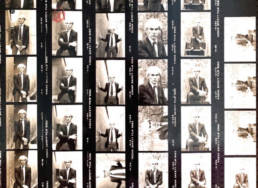
Even obscured by hats and goggles, Warhol could sniff out a VIP at 50 paces.
“I remember him talking about Reggie Jackson and other stars in the ski lift line. His star-spotting was amazing anywhere we went,” recalls photographer Mark Sink, who worked at interview, the cultural magazine founded by Warhol and regarded as the crystal ball of pop. Talking at the base with Sink, Warhol soaked up the neon fashion and the ‘flying wedges’ that are alpine life. Calling it the day after hurting his hand in a fall, “His Ro lex hurt his wrist,” Sink explained.
The sport was just the tip of the Aspen iceberg. Warhol likely only indulged in actual skiing because it was so ripe with celebrity viewing. He wouldn’t be the first.
No time for dillydallying, Warhol was in town for starstudded kicks- the third wedding of Sonny Bono, to 26-year-old actress Susie Coelho, a New Year’s Eve candlelit affair at Prince of Peace Church. Attended by assorted celebs du jour, from Pittsburgh Steeler Lynn Swann to actress Mimi Rogers, Warhol’s fondness for icons of the ’60s and ’70s sprinkled in celebrity kitsch was well satisfied.
Typically, this was just the start of another schmoozy Aspen night.
December 31st meant flitting from the Bono nuptials to Jimmy Buffet’s annual soiree at the Meadows, to Cathy Lee Crosby’s after-party for the newlyweds. Aspen’s traditionally frantic holiday party mode suited Warhol’s social appetites, a demanding Champagne-fueled agenda requiring many stops and a good local driver.
Aspen also served up some rich art-world networking. The legendary artist, whose works now fetch in excess of $100 million, was as star-struck as many less-known visitors. The previous summer, Warhol had come to Aspen at the invitation of local John and Kimiko Powers, major modern art collectors and some of his biggest patrons. In their decades of attracting international art stars to the mountain town, the Powers had attracted such luminaries as Roy Lichtenstein to paint cartoon strips and Christo to string a billowing curtain across Rifle Gap. Never easily satisfied, on arriving at the Powers’ home the first thing Warhol did was call the world’s most powerful actor, Jack Nicholson. He agreed to meet the next day. “And it was just like talking in a movie, talking to Jack on the phone. It was so exciting.”
Warhol kept a meticulous social diary, his daily impressions
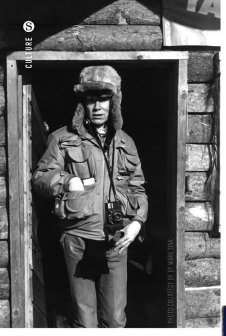
dictated in a low soft voice. Next up: John Denver was coming for dinner. He – and the rest of the world – had been reading the gossip about Denver’s marital problems at the time, so when the doorbell rang, “There they were, and we said we knew all about them, and they didn’t have to talk. And they thought it was funny.”
Though he didn’t always understand the great outdoors, Warhol acknowledged he possessed what was a more poetic than realistic yearning for it. In his book titled America, he wrote, “When you leave the city and go out in the country you’re always tempted to think, ‘This is the real America.’ The air smells so great and all the land with nothing on it looks so peaceful…” More than once he observed, “Land is the best art.”
The Powers had first brought Warhol to town during their tenure running the cutting-edge Aspen Center for Contemporary Art (ACCA). It was the mid-1960s, and Aspen was one of the most important avant-garde art communities in the country- according to art historian Dean Sobel, “a Shangri-la for the art world’s inner circle.
I Remember him to talking about Reggie Jackson and other stars in the ski lift line. His star support was amazing anywhere we went”
Though Warhol never had a residency with ACCA, he did participate in local exhibitions sponsored by Powers. And in 1966 he guest-edited the third issue of the aggressively experimental arts culture magazine called Aspen, founded by part-time Aspenite Phyllis Johnson, former editor at Women’s Wear Daily and Advertising Age – early illustrations of the kinds of remarkable connections and synergies that already existed in Aspen. Not to mention the attention-grabbing socializing.
By the early ’80s, Warhol’s distinctly East Coast vibe was more commonly represented in the town, mingling with the long-established Hollywood-in-themountains atmosphere. Among Warhol’s contributions to local art are images he took of the town and its people. Some appear in America, some in private, collections, and others are owned by the Andy Warhol Foundation for the Visual Arts. He also did local portrait commissions, including a screen print of Kimiko Powers often seen in the company of his Maos, Marilyns, and Micks.
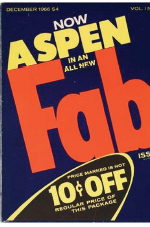
The Aspen overlap between Warhol’s most animated passions – art and high society – was exemplified by the Aspen Tennis Festivals in 1983 and 1984. Held at the Aspen Club to benefit the United Cerebral Palsy Research and Educational Foundation, it featured star-studded exhibition tennis matches with John McEnroe, Bjorn Borg, Vitas Gerulaitis, Senator Ted Kennedy, Jill St. John, and a host of others. Warhol arrived one day on the back of a Harley Davidson driven by Jack Nicholson, and later attended the fundraising auction emceed by legendary sports announcer Howard Cosell.
a Warhol portrait of the buyer was on the block it drew so much interest Warhol quickly agreed to four further ones – at $40k each, raising a quick and breathtaking $160,000 for the cause.
It was a generous flourish during what would be Warhol’s last trip to Aspen before his death in 1987. The cliche about Aspen is that real locals come for the skiing but stay for the people. That obviously didn’t apply to Warhol but – like many of those who love the valley-he did come back for the people, Aspen’s beautiful people.
